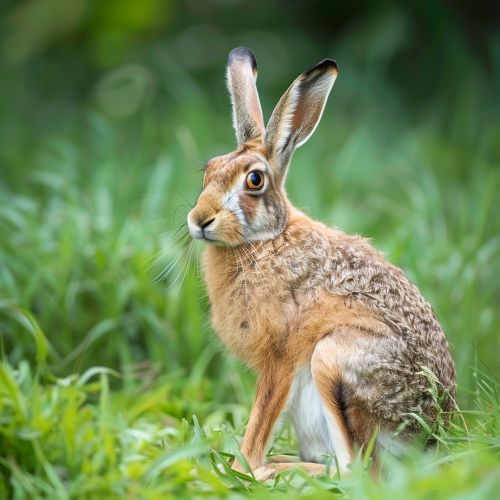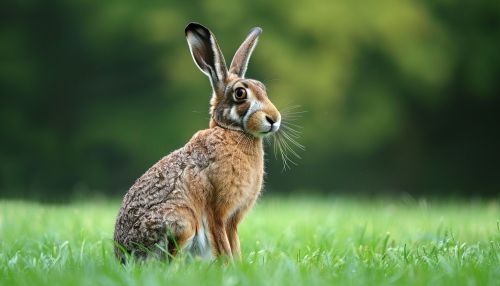Lepus: Difference between revisions
(Created page with "== Introduction == The genus ''Lepus'', commonly referred to as hares, is a group of mammals in the family Leporidae. This genus is characterized by its members' long ears, powerful hind legs, and swift running capabilities. Hares are distinct from rabbits, although they share many similarities and are often confused with each other. This article delves into the taxonomy, morphology, behavior, habitat, and ecological significance of ''Lepus'' species, providing a compre...") |
No edit summary |
||
| Line 34: | Line 34: | ||
The fur of hares varies significantly among species and is often adapted to their specific environments. For instance, the [[Snowshoe Hare|snowshoe hare]] has white fur during winter to blend with the snow, while the [[European Hare|European hare]] has a brownish coat that provides camouflage in grassy fields. | The fur of hares varies significantly among species and is often adapted to their specific environments. For instance, the [[Snowshoe Hare|snowshoe hare]] has white fur during winter to blend with the snow, while the [[European Hare|European hare]] has a brownish coat that provides camouflage in grassy fields. | ||
[[Image:Detail-91331.jpg|thumb|center|A European hare sitting in a grassy field.|class=only_on_mobile]] | |||
[[Image:Detail-91332.jpg|thumb|center|A European hare sitting in a grassy field.|class=only_on_desktop]] | |||
== Behavior and Ecology == | == Behavior and Ecology == | ||
Latest revision as of 18:41, 21 June 2024
Introduction
The genus Lepus, commonly referred to as hares, is a group of mammals in the family Leporidae. This genus is characterized by its members' long ears, powerful hind legs, and swift running capabilities. Hares are distinct from rabbits, although they share many similarities and are often confused with each other. This article delves into the taxonomy, morphology, behavior, habitat, and ecological significance of Lepus species, providing a comprehensive overview for those interested in mammalian biology.
Taxonomy and Classification
The genus Lepus falls under the order Lagomorpha, which also includes rabbits and pikas. The family Leporidae encompasses both hares and rabbits, but Lepus is specifically designated for hares. The genus was first described by Carl Linnaeus in 1758.
Species Diversity
There are over 30 recognized species within the genus Lepus. Some of the notable species include:
- Lepus europaeus (European Hare)
- Lepus americanus (Snowshoe Hare)
- Lepus californicus (Black-tailed Jackrabbit)
- Lepus arcticus (Arctic Hare)
- Lepus timidus (Mountain Hare)
Each species has adapted to its specific environment, ranging from the temperate regions of Europe to the icy tundras of the Arctic.
Morphology
Hares are known for their distinctive physical features, which include long ears, large hind legs, and a lean body structure. These adaptations are crucial for their survival in various habitats.
Ears
The elongated ears of hares serve multiple functions. They are highly sensitive to sound, aiding in the detection of predators. Additionally, the ears play a role in thermoregulation, allowing hares to dissipate heat in warmer climates.
Limbs
Hares possess powerful hind legs that enable them to run at high speeds, often exceeding 70 km/h. This agility is essential for evading predators. The hind legs are also adapted for leaping, which is a common mode of locomotion in many Lepus species.
Fur
The fur of hares varies significantly among species and is often adapted to their specific environments. For instance, the snowshoe hare has white fur during winter to blend with the snow, while the European hare has a brownish coat that provides camouflage in grassy fields.


Behavior and Ecology
Hares exhibit a range of behaviors that are crucial for their survival and reproduction. They are generally solitary animals, although some species may form loose groups.
Reproduction
Hares have a high reproductive rate, which is vital for their survival given the high predation rates they face. Females, known as does, can give birth to multiple litters each year, with each litter containing several leverets (young hares). Unlike rabbits, leverets are born fully furred and with their eyes open, allowing them to be relatively independent from birth.
Feeding Habits
Hares are herbivorous, feeding primarily on grasses, herbs, and other vegetation. Their diet can vary seasonally, with some species consuming bark and twigs during the winter months when other food sources are scarce.
Predation and Defense
Hares are preyed upon by a variety of predators, including foxes, eagles, and humans. Their primary defense mechanisms include their speed and agility, as well as their ability to remain motionless to avoid detection.
Habitat and Distribution
The genus Lepus is widely distributed across the globe, inhabiting diverse environments from deserts to tundras.
Temperate Regions
In temperate regions, such as Europe and North America, hares are commonly found in open fields, meadows, and agricultural lands. The European hare is particularly well-adapted to these environments.
Arctic and Alpine Regions
Species like the Arctic hare and mountain hare are adapted to cold environments. They have thick fur and are capable of surviving in harsh, snowy conditions.
Desert and Semi-Arid Regions
The black-tailed jackrabbit is an example of a hare that thrives in desert and semi-arid regions. These hares have adaptations such as large ears for heat dissipation and a diet that includes moisture-rich plants.
Ecological Significance
Hares play a crucial role in their ecosystems. They are primary consumers, feeding on vegetation and serving as prey for a variety of predators. Their feeding habits can influence plant community dynamics, and their presence can indicate the health of an ecosystem.
Impact on Agriculture
In agricultural settings, hares can be both beneficial and detrimental. While they help control weed populations by feeding on certain plants, they can also cause significant damage to crops, leading to conflicts with farmers.
Conservation Status
The conservation status of Lepus species varies. Some species, like the European hare, are abundant and widespread, while others, such as the hispid hare, are considered endangered due to habitat loss and hunting pressures.
